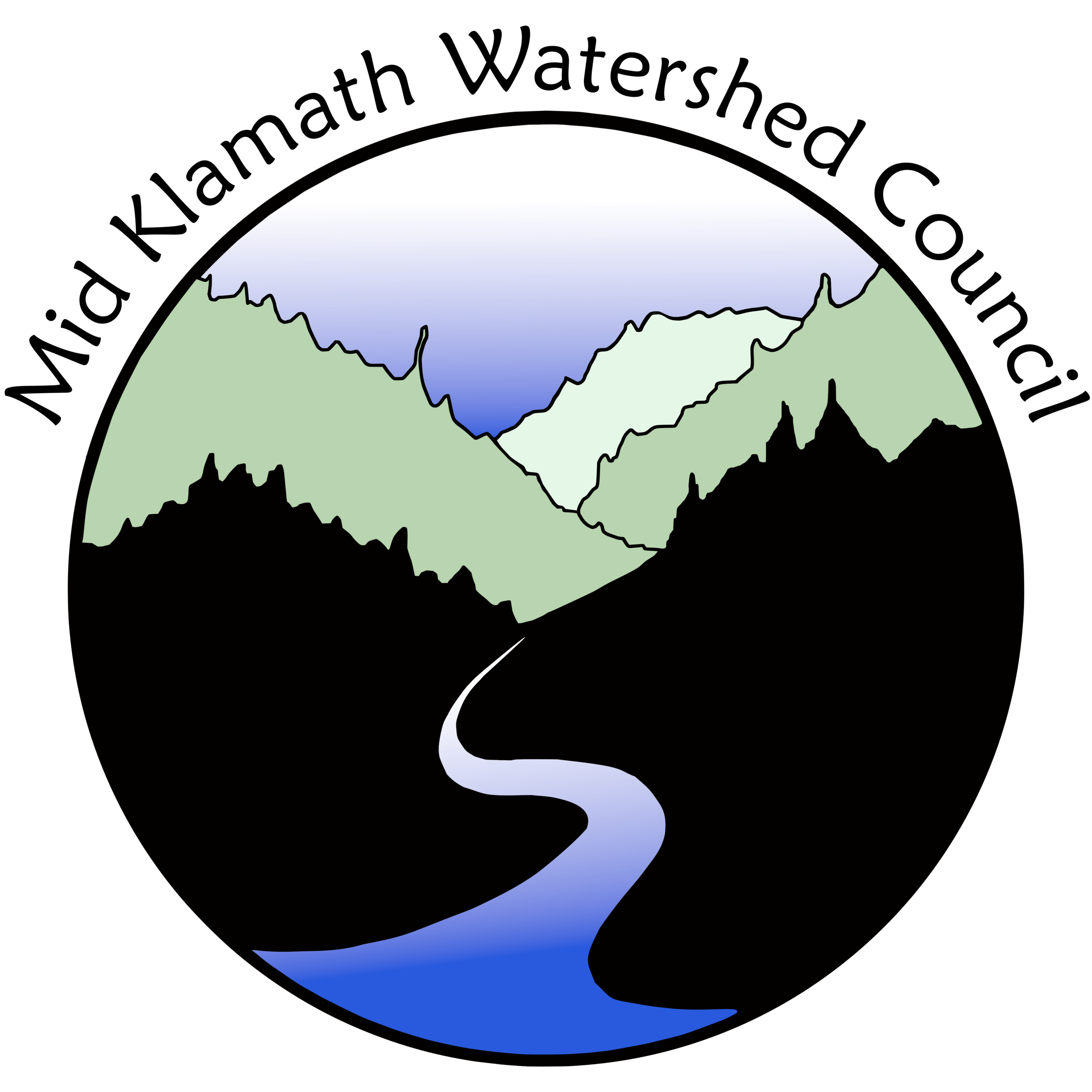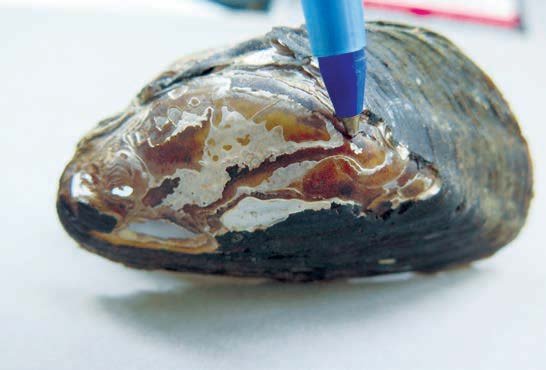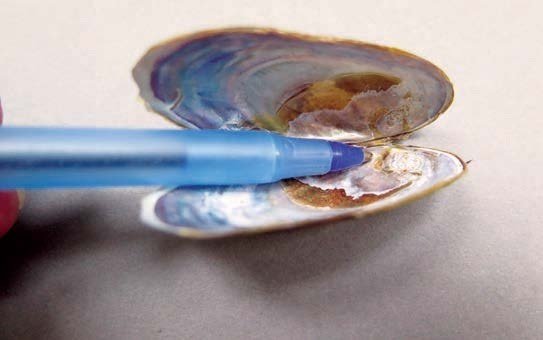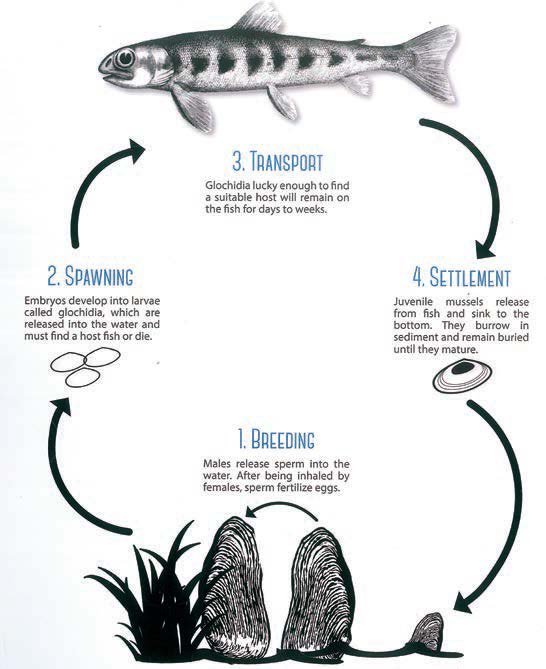Klamath River Freshwater Mussels
Last month, Mitzi Wickman, MKWC Fisheries Project Coordinator, joined Emilie Blevins, Xerces Society Senior Endangered Species Conservation Biologist and Freshwater Mussel Lead, on a scuba dive trip in the Klamath River. They were observing the freshwater mussel beds at Horse Trough Springs to ensure that a future restoration project to remediate mine tailings and reconnect the river to its historic floodplain wouldn't impact these mussel beds. Freshwater mussels in the river provide a major ecosystem service, and they aren't talked about much! Mitzi's dive last month had us all thinking more about freshwater mussels and we are happy to rekindle this informative article Mitzi wrote about Klamath freshwater mussels back in 2018.
Klamath River Freshwater Mussels
Did you know that the Klamath River is home to three kinds of native mussels? Did you also know that these mussels spend a portion of their life cycle attached to fish gills? And more amazingly, only on specific fish species?!!!!!! Did you know that some of these native mussels live to be over a 100 years old? (They have age rings like a tree!) It is possible there are mussels in the Klamath River that have been there since the year 1918! Read on to find out more about the Klamath River’s native mussels.
Klamath River mussel bed above Rock Creek on 7-5-18
What Is A Mussel?
First of all, what is a mussel? A mussel is an animal with two shells connected at a hinge point. It has a fleshy interior. Mussels are a food source for many animals including otters, raccoons, herons, and egrets. Mussels can be found partly buried in the streambed. They secure themselves by protruding their foot in the soft sandy river bottom. They can be found throughout the length of the Klamath River from above Upper Klamath Lake nearly to the Pacific Ocean. There are mussel beds ranging in size from a couple mussels to thousands of mussels.
How To Distinguish Between The Native Mussel Species In The Klamath
The species of mussels native to the Klamath River are the western ridged mussel, (Gonidia angulata), the western pearlshell mussel (Margaritifera falcata), and floaters like the Oregon (Anodonta oregonensis) and western floater (Anodonta kennerlyi), and the winged or California floater (Anodonta nuttalliana). If you have an empty shell in hand (possibly courtesy of a hungry otter), you can tell these species apart by looking for some distinguishing characteristics, described below and shown in the photos.
The western ridged mussel (Gonidia angulata) has a prominent ridge on its shell. They do have small pseudocardinal teeth. (The Klamath River is unique in that the western ridged mussel is its most abundant mussel, unlike most large rivers in the Pacific Northwest. Most other Pacific Northwest rivers are dominated by the western pearlshell mussel.) (left photo)
The western pearlshell mussel (Margaritifera falcata) does not have this ridge but does have very prominent pseudocardinal teeth. (middle photo)
The floaters (genus Anodonta) do not have ridges and do not have any pseudocardinal teeth. There is no way to tell the difference between species in the Anodonta genera without the help of DNA laboratory work. (right photo)
Do Mussels Really Filter Water?
Mussels filter up to a liter of water per hour! They do this because they need oxygen, and they are eating small animals, plants, algae, and bacteria suspended in the water. They inhale water, filter the water through their gills and then expel the clean water. In addition to expelling clean water, the mussels get rid of things in the water that they don’t want in the form of pseudofeces. It is theorized that fish are attracted to this clean water as well as the pseudofeces food. So not only do mussels need fish so their young can develop into juveniles, but it seems fish benefit from mussels! Check out this video to see mussel filtering in action.
Life Cycle of Mussels
Figure 1 is a diagram of the freshwater mussel life cycle, courtesy of the Xerces Society. (The Xerces Society focuses on the conservation of invertebrates considered to be essential to biological diversity and ecosystem health.) What amazes me most about the mussel life cycle is that a vital portion of their life is spent attached to the gills of specific fish. The following table shows which fish hosts the immature (glochidia) mussels for each of the native mussel species found in the Klamath River.
Mussel Species
Western ridged mussel (Gonidia angulata)
Western pearlshell mussel (Margaritifera falcata)
Oregon/western floater (Anodonta oregonensis)
Winged/California floater (Anodonta nuttalliana)
Fish Host
Sculpin and dace (not confirmed)
Salmonids
multiple species like stickleback, dace, shiner, and sculpin
multiple species like stickleback, dace, shiner, and sculpin
Check out the this page to see a mussel tricking a fish to get close enough so that the mussel can expel its young onto the fish’s gills.
How are Mussels doing?
The western ridged mussel has experienced a 43% decline in range since it was first discovered in the 1800s! That is disheartening and is one of the reasons why the International Union for Conservation of Nature listed both the western ridged mussel (Gonidea angulata) and the winged/California floater (Anodonta nuttalliana) to the list of Vulnerable species.
What can we do to protect the Klamath River mussels?
While conducting fisheries restoration projects, we can not only try to minimize damage to mussels, we can incorporate improving mussel habitat into project designs. While attending a freshwater mussel workshop in Happy Camp in August of 2018, coordinated by the Salmon River Restoration Council and presented by Emilie Blevins from the Xerces Society, attendees learned hands on techniques on how to identify, avoid disturbing, and how to relocate Klamath River native mussels. It was interesting to hear that there is a plan in place for protecting mussels for the Klamath River Dam Removal Project and it involves relocating 20,000 mussels from below Iron Gate Dam to below Keno Dam. The Mid Klamath Watershed Council has multiple Klamath River mainstem fisheries projects in the works and plans to utilize the information found in the Xerces Society publication (Conserving the Gems of Our Waters: Best Management Practices for Protecting Native Western Freshwater Mussels During Aquatic and Riparian Restoration, Construction, and Land Management Projects and Activities, 2017: https://xerces.org/conserving-the-gems-of-our-waters/).
If you would like to learn more about mussels, check out the Xerces Society web page!





